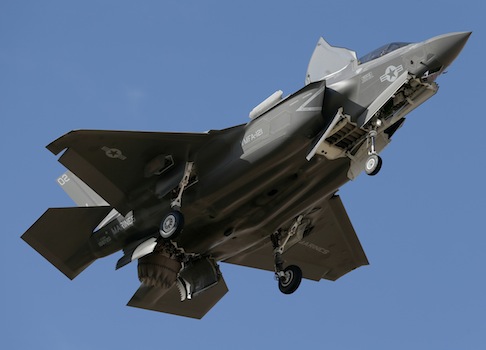A major delay in the shipment of new F-35 fighter jets is expected to diminish U.S. "warfighting capabilities" across the globe and force the Pentagon to significantly boost funding for the plane at a time when military leaders say they cannot afford to, according to a new government report.
Delivery of the plane could be deferred "by as much as 13 months," leading the Government Accountability Office (GAO) to warn that "delays of this magnitude will likely limit the warfighting capabilities that are delivered to support the military services' initial operational capabilities," according to the report.
The F-35 manufacturers are reportedly running into major problems completing and testing "critical software" that allows the jet to properly operate.
The problems will not just deprive the Pentagon of the plane, but force it to "increase funds steeply over the next 5 years and sustain an average of $12.6 billion per year through 2037" and about $15 billion over the next several years.
The key fighter jet was originally meant to be shipped by July 2015, though the delay will push this back to 2016, according to the report.
This could be problematic given current budgetary constraints on the Pentagon and a plan to cut funding in many key areas. The F-35 program has already been ordered to reduce costs.
"Annual funding of this magnitude clearly poses long-term affordability risks given the current fiscal environment," according to the GAO report. "The program has been directed to reduce unit costs to meet established affordability targets before full-rate production begins in 2019, but meeting those targets will be challenging as significant cost reductions are needed."
"Additionally, the most recent cost estimate for operating and supporting the F-35 fleet is more than $1 trillion, which DoD officials have deemed unaffordable," according to the report.
Potentially more problematic for the aircraft and the military is a recent finding by the Office of the Director for Operational Test and Evaluation (DOT&E) determining that "the F-35 program has limited additional opportunities to improve reliability."
The uncertainty about the F-35 means that "Congress and the military services may not be able to make fully informed resource allocation decisions," according the report.
The primary problem for the F-35 is that it is suffering from software malfunctions.
"Challenges" have arisen specifically in the "development and testing" of software that governs the jet's mission systems. This occurred as a result of initial delays in the "software delivery, limited capability in the software when delivered, and the need to fix problems and retest multiple software versions," according to the GAO.
The F-35, also know as the Joint Strike Fighter, has the title of being the "DoD’s most costly and ambitious acquisition program," according to the report. Versions of the plane are used by the Air Force, Navy, and Marine Corps, as well as eight U.S. allies.
Despite its problems, "the F-35 is integral to U.S. and international plans to replace existing fighter aircraft and support future combat operations," the report states.
"Total U.S. planned investment in the F-35 program is approaching $400 billion to develop and acquire 2,457 aircraft through 2037, plus hundreds of billions of dollars in long-term spending to operate and maintain the aircraft," according to the report.
